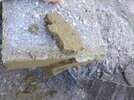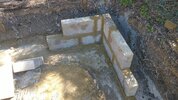First time building anything with mortar. I put up a block wall and used a ratio of 4:1 sand:cement with a splash of plasticiser. The mortar had a smooth texture, kept it's form, stayed on the trowel and was easy to apply if I wet the blocks a bit.
The following morning it seemed to set and the wall felt sturdy but if I shook the block vigorously enough I could pry it loose. I put it up in 13 degrees. But overnight the temperature was 4 degrees since midnight dropping to 0 degrees at 06:00 for an hour.
I tore it down because of a different reason but this time I want to make sure its right.
I put up another corner (picture 2) trying making to make sure I used the precise ratio but this time I feel it was a bit too wet? It definitely felt a bit soupy when pointing.
The following morning it seemed to set and the wall felt sturdy but if I shook the block vigorously enough I could pry it loose. I put it up in 13 degrees. But overnight the temperature was 4 degrees since midnight dropping to 0 degrees at 06:00 for an hour.
I tore it down because of a different reason but this time I want to make sure its right.
I put up another corner (picture 2) trying making to make sure I used the precise ratio but this time I feel it was a bit too wet? It definitely felt a bit soupy when pointing.



